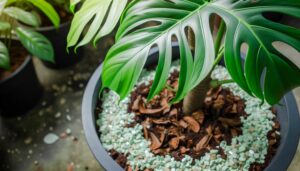Monstera Adansonii Vine No Leaves: Causes and Solutions!
If your Monstera Adansonii vine has no leaves, it’s likely due to improper care. Insufficient light, improper humidity, and temperature fluctuations can stress the plant.
Ensure bright, indirect light and maintain humidity between 60% and 80%. Both overwatering and underwatering lead to leaf loss; let the top inch of soil dry out between waterings.
Nutrient deficiencies, particularly nitrogen, phosphorus, and potassium, can also cause leaf drop. Additionally, pests and diseases like spider mites and fungal infections might be affecting your plant.
Your plant’s health depends on proper care, and mastering these aspects will demonstrate why this could be happening.

Key Takeaways
- Check for insufficient light, as inadequate light can cause leaf drop and sparse foliage.
- Inspect for pests like spider mites and aphids, which can damage leaves and hinder vine health.
- Monitor soil moisture to avoid overwatering, which leads to root rot and leaf loss.
- Ensure humidity levels are between 60% and 80% to prevent leaf shedding.
- Correct nutrient deficiencies, especially nitrogen, phosphorus, and potassium, to support healthy leaf growth.
Environmental Stress Factors

Environmental stress factors, such as insufficient light, improper humidity levels, or extreme temperature fluctuations, can cause a Monstera Adansonii vine to shed its leaves.
You need to provide bright, indirect light to mimic its natural habitat. Low light can stunt growth and lead to leaf drop.
Additionally, maintaining humidity levels between 60% and 80% is essential since this plant thrives in tropical conditions. If the air is too dry, you might notice browning or curling leaves before they eventually fall off.
Temperature fluctuations, particularly drafts or sudden cold snaps, can also be harmful. Ensure stable temperatures between 65°F and 80°F.
Improper Watering Practices
You’re likely to see root rot and leaf drop if you consistently overwater your Monstera Adansonii, as excess moisture promotes fungal infections.
Conversely, underwatering can cause leaf curling, browning, and eventually, leaf loss due to insufficient hydration and nutrient transport.
Both improper watering practices disrupt the plant’s physiological balance, leading to a bare vine.
Overwatering Consequences
Excessive watering leads to root rot, which in turn causes Monstera Adansonii vines to lose their leaves due to impaired nutrient uptake. When you overwater, the soil becomes waterlogged, depriving roots of oxygen. This anaerobic environment fosters pathogenic fungi like Pythium and Phytophthora.
You’ll notice leaves yellowing and wilting, followed by abscission. Roots turn brown, mushy, and emit a foul odor, indicating rot. Overwatered plants struggle with nutrient deficiencies because damaged roots can’t efficiently absorb essential minerals.
Maintain a consistent watering schedule and ensure adequate drainage to prevent these issues. Use a moisture meter to gauge when to water, keeping the soil slightly moist but not saturated. This practice helps sustain healthy root systems and vibrant foliage.
Underwatering Symptoms
Inadequate watering practices can cause Monstera Adansonii vines to exhibit symptoms like crispy, browning leaf edges and stunted growth due to insufficient hydration. When you underwater, the plant’s root system struggles to uptake necessary nutrients, leading to chlorosis and eventual necrosis of leaf tissues.
Observing soil moisture is essential; a dry, compacted substrate indicates a lack of water. The plant’s physiological processes, such as photosynthesis and transpiration, become impaired, resulting in reduced turgor pressure and wilting. Additionally, you may notice a delay in new leaf emergence or smaller leaves forming.
To prevent these issues, maintain a consistent watering schedule that keeps slight soil moisture, avoiding prolonged dryness. Proper hydration supports the plant’s metabolic functions and overall health.
Lack of Nutrients

A Monstera adansonii vine without leaves can often signal a lack of necessary nutrients, particularly nitrogen, phosphorus, and potassium, which are essential for its growth and foliage development.
Nitrogen deficiency manifests as stunted growth and yellowing leaves, while phosphorus deficiency can cause dark green or purplish foliage. Potassium deficiency usually results in weak stems and leaf edges browning.
Here’s a quick reference table:
| Nutrient | Deficiency Symptoms | Importance |
|---|---|---|
| Nitrogen | Yellowing leaves, stunted growth | Promotes leaf and stem growth |
| Phosphorus | Dark green/purplish foliage | Essential for energy transfer and root development |
| Potassium | Browning leaf edges, weak stems | Aids in water regulation and enzyme activation |
Ensuring your Monstera receives balanced nutrition can restore its health.
Insufficient Light Exposure
Insufficient light exposure can severely hinder the photosynthetic process, leading to sparse foliage and weakened growth in your Monstera adansonii vine. Without adequate light, chlorophyll production diminishes, reducing energy synthesis essential for growth.
You’ll notice elongated stems, fewer leaves, and a pale green hue indicating chlorosis. To optimize light conditions, consider:
- Bright, indirect sunlight: Place your vine near an east or north-facing window.
- Artificial grow lights: Use full-spectrum LEDs if natural light is limited.
- Rotate the plant: Guarantee even light distribution by turning the pot regularly.
- Monitor light intensity: Use a light meter to sustain ideal levels between 10,000 to 20,000 lux.
Pests and Diseases
You may notice your Monstera Adansonii losing leaves due to pests like spider mites and scale insects, which cause significant damage.
Keep an eye out for signs of fungal infections such as leaf spots and root rot, which also contribute to leaf loss.
Implement preventive measures like regular inspection and proper watering to maintain plant health.
Common Insect Infestations
In the domain of pest infestations, spider mites and aphids frequently afflict Monstera adansonii, compromising its vine health and leaf development.
You might notice stippling on the leaves, which indicates spider mite activity. Aphids, on the other hand, excrete honeydew, leading to sooty mold development on the plant. Both pests feed on the plant’s sap, weakening it over time.
To help you identify and manage these pests, consider the following:
- Spider mites: Tiny, web-spinning mites that cause yellowing leaves.
- Aphids: Small, soft-bodied insects that cluster on new growth.
- Stippling: Tiny dots on leaves, a sign of spider mite feeding.
- Honeydew: Sticky residue from aphids, leading to mold.
Understanding these signs helps you take prompt action.
Fungal Infections Signs
Fungal infections, often manifesting as root rot or leaf spots, pose significant threats to Monstera adansonii, diminishing its overall vigor and aesthetic appeal.
You’ll notice root rot when the roots turn black, mushy, and emit a foul odor, indicating a breakdown of cellular structure due to fungal pathogens like Phytophthora or Pythium.
Leaf spots, on the other hand, appear as dark, water-soaked lesions, often with a yellow halo, primarily caused by fungi such as Colletotrichum. These infections can lead to necrosis, where affected tissues die, causing leaves to fall prematurely.
Monitoring for discoloration, wilting, and unusual textures on roots and foliage is essential to identify fungal infections early and mitigate their impact.
Disease Prevention Tips
Regularly examining your Monstera adansonii for early signs of pests and diseases is crucial for maintaining its health and averting widespread infestations. Examine the leaves closely for discoloration, spots, or unusual patterns. Pay close attention to the undersides where pests often conceal themselves. Utilize a magnifying glass for detailed observation.
Neem oil application: Apply neem oil to the leaves to discourage pests and manage fungal infections.
Proper air circulation: Maintain good airflow around your plant to decrease humidity and inhibit fungal growth.
Quarantine new plants: Isolate new plants for a few weeks to prevent introducing pests and diseases to your existing collection.
Regular cleaning: Clean the leaves with a moist cloth to eliminate dust and potential pests.
Pruning and Training
Pruning and training your Monstera adansonii involve carefully cutting back overgrown vines and strategically guiding new growth to maintain a healthy, aesthetically appealing plant structure. Begin by using sterilized pruning shears to trim any leggy, leafless stems close to a node, where new growth can emerge.
Focus on removing dead or damaged leaves to prevent disease spread. When training, use supports like trellises or moss poles to direct the plant’s natural climbing habit. Gently tie stems with plant ties, making sure not to constrict growth.
Regularly rotate the plant to guarantee even light distribution, promoting symmetrical development. These practices encourage robust growth while preventing the plant from becoming unruly and preserving its decorative appeal.
Reviving Your Monstera Adansonii

To revive your Monstera adansonii, identify the underlying issues such as inadequate lighting, improper watering, or pest infestations that may be hindering its growth. Make sure your plant receives bright, indirect light to mimic its natural habitat.
Overwatering can lead to root rot, so allow the top inch of soil to dry out between waterings. Additionally, check for common pests like spider mites or aphids and treat them promptly.
- Adjust the lighting conditions to provide bright, indirect light.
- Monitor soil moisture and avoid overwatering by allowing the soil to dry.
- Inspect the plant regularly for pests and apply appropriate treatments.
- Consider using a balanced, water-soluble fertilizer to enhance nutrient intake.
- With these steps, you’ll help your Monstera adansonii thrive again.
Conclusion
So, you’ve tackled environmental stress, fixed watering mishaps, corrected nutrient deficiencies, boosted light exposure, battled pests, and pruned strategically.
Coincidentally, each step aligns perfectly to revive your Monstera adansonii. You’ll notice new leaves sprouting as your plant thrives again.
Remember, it’s a combination of factors causing leafless vines, and your detailed approach guarantees a robust recovery. Keep monitoring and adjusting, and soon, your Monstera will reward you with lush, green foliage.






